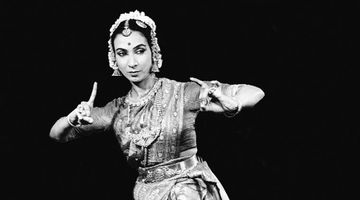Mrinalini Sarabhai - an inspiration
“I cry out my emotions in dance,” Mrinalini Sarabhai would often say. The Padma Bhushan recipient took Bharatnatyam to the world stage at a time when it was limited to the court dancers in India.
Born long before Independence, she realised her ‘being’ through dance that also symbolised her thoughts of the cosmos. An amalgam of the traditional and the contemporary, she initiated an era of choreographed ‘dance dramas’ raising the social issues of environment, gender and social inequality.
Inspiration
The seeds of performing and professionalism were present in Mrinalini as a four year old. She had to recite a poem ‘rock on the horse’ while jumping on a wooden horse. Its head broke, but unfazed she continued. Much later, when the broken glass beads of her Kathakali costumes cut her foot, she danced with a septic foot taking shots of penicillin during the intervals at St. Martin’s theatre in London. Her first brush with the theatre was as a seven year old child essaying the role of a boy scared by the drunkard father in the play, “Parrot puppet”.
Her schooling in Switzerland introduced her to Greek dance forms. Two years in the lap of nature also inspired her to protect nature. She learnt Bharatnatyam on returning to India. However, her mother did not take her love for dance seriously. The breakthrough came when she went to the ‘abode of peace,’ Shantiniketan. Rabindranath Tagore chose her for the play ‘Chandalika’ after seeing her dance. For the first time she got the opportunity to express herself by choreographing Bharatnatyam for her part. The experimentation released her from the shackles of stiff tradition, though she stuck to the base rules. There she learnt many classical dance forms like Manipuri from dedicated teachers.
As a youngster she learnt Serimpi dance of Indonesia from Pangeran (Prince) Tedjoekoesoemo. She also studied dramatics at the American Academy of Dramatic Arts for six months. The meditation at dawn in Shantiniketan was instrumental in drawing her to eternal inner pursuits. She was deeply attached to Indian traditions. She adored the bindi and the saree till her last day. She never aped the West.
The plight of women in Gujarat led her to choreograph a dance drama ‘Memory’ to raise the issue of ‘dowry deaths’ from burns. Her grandmother was a matriarch. Her mother was the first president of the Indian Women Congress and a social activist fighting for women’s rights. Her sister headed the women wing of the Indian National Army of Subhash Chandra Bose. In her formative years she came in contact with the likes of Mrs. Cousins who introduced the Devdasi Bill.
She continued with the spirit of welfare when she transformed the graduating ceremony of ‘arangateyam’ at her dance academy to ‘aradhana.’ She did it to cut the costs and bring equality among the students coming from different economic backgrounds.
In Paris, she made the foreign students enact Bharatnatyam who were stiff to the mudras. In Italy, she performed a fusion ‘The Creatures of Prometheus’ with the ballet dancers to the tunes of Beethoven directed by Bepe Menegatti for the great musician’s centenary celebrations in Italy.
She also initiated the ‘Friends of Tree’ movement to save the trees.
Challenges
She lost her father at an early age, that left a void in her heart. A Malyali married in a Guajarati family she had to overcome the cross-cultural barriers, such as, food (like the boiled bottle gourd without spices).
When her husband, Vikram Sarabhai, a leading space scientist of India went to Cambridge for a doctoral programme, she moved too. It was only after returning that she practised with Meenakshi Sundaram Pillai to a gruelling schedule of ten hours a day, with Kartikeya, her first child crawling around. The couple made sure that one parent was always there with the kids when the other went on tours. The two men of the family, her husband and father-in-law supported her by attending every possible performance. Coming from the affluent family of Swaminadhans and married to Vikram Sarabhai, she was written off the dance scene by great art critiques like G. Venkatachalam.
She started her dance academy, Darpan, as the Sarabhai couple shared a vision to bring the classical dance forms to Gujarat. It went on to become a great success with disciples coming from UK and USA to learn and live the classical forms of dance.
Whatever the couple saved always went to their respective institutions. After her husband’s death, her finances dwindled since the Sarabhai Group of Industries’ share values dropped. She relied on her inheritance from her father’s will to go to the UK for her daughter’s treatment.
She left behind a legacy of rational thinking, sensitivity to the social and environmental issues, and a passion to create sustainable institutions to bring a constructive change in the society. May ‘Amma’ as she was fondly called, embark on her new journey with élan!
















